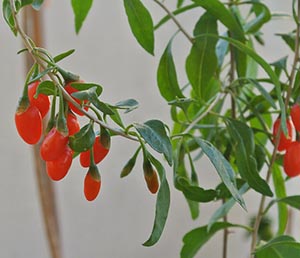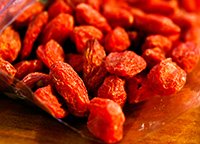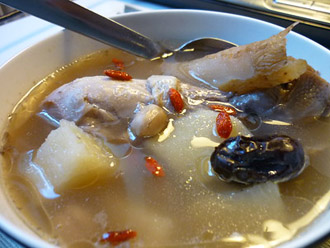Goji berry Nutrition facts
In Chinese legends, the Goji berry symbolizes longevity of life. These tiny orange-red color berries are obtained from a nightshade family plant growing naturally in many Asian and Mediterranean regions.
Botanically, goji belongs to the Solanaceae (nightshade) family of plants. Wolfberry, matrimony vine are other names to goji. Eggplant, tomato, potato are other interesting family members in this nightshade family.
Scientific name: Lycium barbarum. Ningxia province in Northwest China is an important region where wolfberry grew on a commercial scale. Goji berries grown in Ningxia, especially in Zhongning, are renowned worldwide for their exceptional quality.
 |
| Goji berries. Note for orange-red fruits. (Photo by-dsc_4967) |
Goji berry is a deciduous, thick woody vine that prefers loamy, well-drained soil. The two common goji cultivars grown in China are L. barbarum, and L. chinense (Chinese wolfberry). L. barbarum or NingXia (Gou Qi) berries are considered the best and most popular in the Western world.
Goji reaches about 2-3 meters in height and begins fruit yielding by the second year of plantation. The plant bears small, purple flowers in the summer, which undergo self-pollination to develop green, raw berries in bunches. The berries turn deep orange-red and can be ready for harvesting by August.
Goji berry measures about 2 to 2.5 cm in length and 1 cm in diameter, has an ellipsoid shape, and waxy, glossy skin. Inside, it consists of tiny, creamy-white, flat seeds interspersed at its center.
Traditionally, fresh berries are harvested by hand-picking and sun-dried for several days, sorted, and dispatched for markets.
Every year during the harvesting time, locals in the Ningxia province celebrate the goji berry festival in the month of August to commemorate the importance of goji berry in their culture.
Health benefits of Goji berry
L. barbarum plant parts, including fruits, leaves, and flowers, have long been recognized as a functional food praised in Chinese culture. The berries, in particular, are packed with an impressive list of essential nutrients, anti-oxidants, vitamins, and minerals.
Dry, red ripe goji berries are concentrated sources of carotenoids, calories, vitamins, and minerals.
Antioxidant carotenoids and flavonoids found abundantly in goji berries. β -carotene, zeaxanthin, cryptoxanthin, and lutein play a vital role in protecting the skin and mucosa from free radical injury.
Certain flavonoids found in goji berries are quercetin, kaempferol, myricetin, hesperidin and rutin. They act as antioxidants, anti-inflammatory, and anti-cancer agents.
Zeaxanthin is a natural antioxidant that has UV (ultra-violet) rays filtering actions in the macula lutea portion of the retina in the eyes. Thus, it may offer protection from "age-related macular disease" (ARMD) in the elderly.
Fresh, as well as, dried goji are excellent sources of vitamin-A. 100 g of dried berries carry astoundingly 26,822 IU of vitamin-A. Vitamin A is a powerful natural anti-oxidant and is required by the body for maintaining the integrity of skin and mucosa. It is also an essential vitamin for good vision. Research studies suggest that natural foods rich in this vitamin may help the human body protect against lung and oral cavity cancers.
Vitamin C is another natural anti-oxidant found in the right concentration in Goji. 100 grams of dried goji compose 48.4 mg or 80% of the daily required levels of this vitamin.
Dried goji berries are an excellent source of calcium (190 mg or 19% of RDI), iron 6.80 mg/100 g of fruits (about 85% of RDI). Iron, being a component of hemoglobin inside the red blood cells, determines the oxygen-carrying capacity of the blood. Calcium is an important mineral that is an essential constituent of bone and teeth and is required by the body for muscle contraction, blood clotting, and nerve impulse conduction.
Further, fresh as well as dry berries carry adequate daily recommended levels of the B-complex group of vitamins. Dried goji contains very good amounts of pyridoxine (vitamin B-6), thiamin niacin, pantothenic acid, and riboflavin. These vitamins act as cofactors to help the human body metabolize carbohydrates, protein, and fats.
| Principle | Nutrient Value | Percent of RDA |
|---|---|---|
| Energy | 349 Kcal | 17% |
| Total sugars | 45.61 g | 35% |
| Protein | 14.26 g | 25% |
| Total Fat | 0.39 g | 2% |
| Cholesterol | 0 mg | 0% |
| Dietary fiber | 13.0 g | 34% |
| Vitamins | Vitamin A | 26,822 IU | 894% |
| Vitamin C | 48.4 mg | 894% | Electrolytes |
| Sodium | 298 mg | 20% |
| Minerals | ||
| Calcium | 190 mg | 19% |
| Iron | 6.80 mg | 85% |
Medicinal uses of Goji berry
Almost all parts of the goji plant have been found to be utilized in traditional Chinese medicine (TCM). Chinese physicians advocate different parts of the plant for each of the four divisions of the year. Its leaves in spring, flowers in summer, fruits in autumn, and roots in winter.
The berries are employed in medicines to cure inflammations, as a blood thinner, as a health tonic for skin and eyes, to relieve nervousness, and to improve memory.
Selection and storage
 |
| Dried goji berries. |
In the United States, dried goji berries are available in supermarkets and Asian stores. Buy authentic branded berries in packs or bins.
In the traditionally cultivated farms, only ripened berries are handpicked from the Goji bush. They are then spread out on stacked, drying beds for 10-16 hours under shade until their waxy skin shrinks and shrivels. Then dried under the sun until there was only 10% moisture left in the berries. Once dried, the berries are sorted and stored in bags and transported to the warehouse for packaging.
Dried goji can store well for up to one year. In highly humid environments, store them in the refrigerator for an extended lifespan.
Raw, fresh berries last for 2-3 days at cold, room temperatures, and for a couple of days in the fridge. Dried berries, however, can store well for several months.
Preparation and serving method
Completely ripe, fresh berries can be eaten hand-picked straight from the bush. Being a member of Solanaceae fruits, eating raw goji could be poisonous, and therefore, should be avoided.
Dried berries can be consumed on their own like raisins. Soaking them in lukewarm water for 5-10 minutes makes them soft and plump.
 |
| Jujube fruit, wolfberry, chicken soup. (Photo-Singzy) |
Here are some serving tips:
Fresh berries can be eaten out of hand as in grapes.
Dry fruits can be used in a much similar way like raisins, in cakes, tart, bread, muffins, etc.
Add them in tea with lemon.
Dried berries can be added to soup with spices and shredded chicken.
Safety profile
Being a member of the nightshade family of plants, goji berries also contain solanine, a glycol-alkaloid toxin.
Patients on anticoagulant medications like warfarin should be advised not to consume these berries and their products like goji berry juice as it may potentiate the anticoagulant effect of warfarin and increase the risk of bleeding. (Medical disclaimer).
≻≻-Back to Fruits from Goji berry. Visit here for an impressive list of all varieties of fruits with complete illustrations of their nutrition facts and health benefits.
≻≻-Back to Home page.
Further reading and Resources: